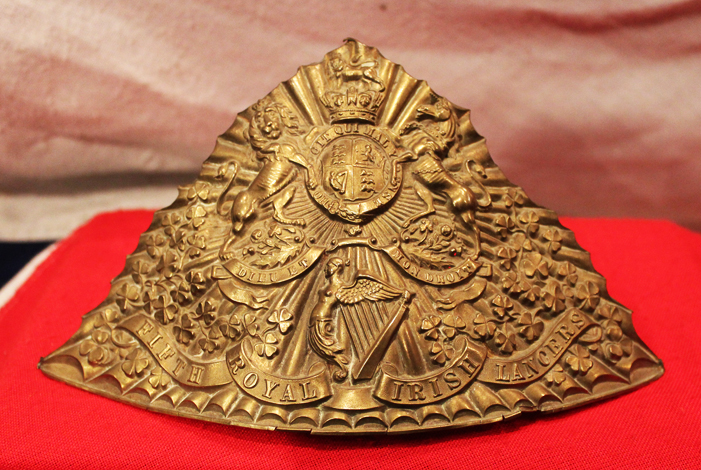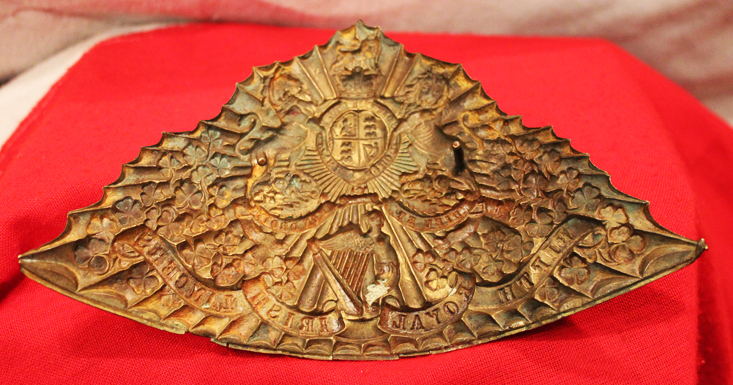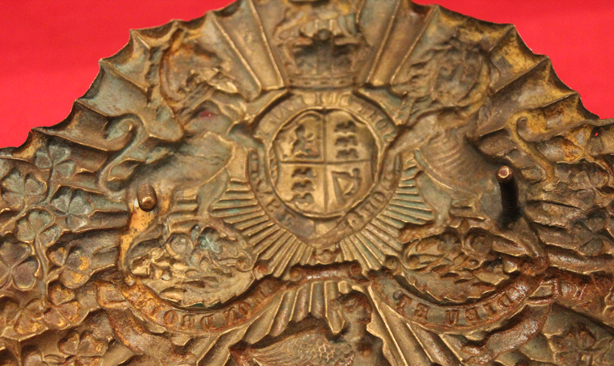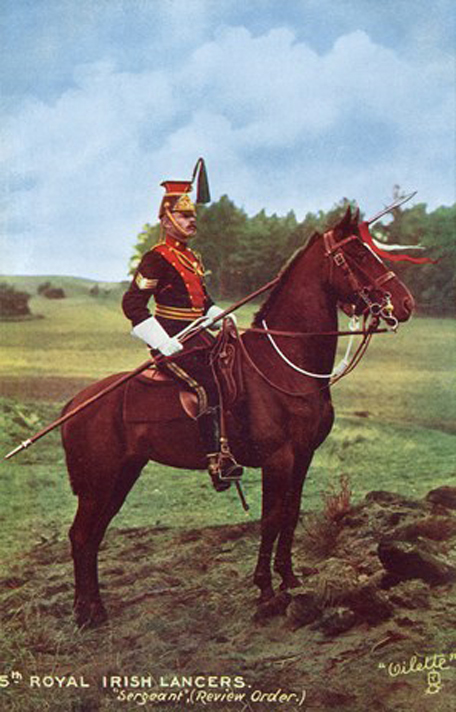A Good Victorian Fifth Royal Irish Lancers Tchapka Helmet Plate
In superb condition, fabulous bronze patina and two helmet screw posts.Queen Victoria's crown. The regiment was originally formed in 1689 as James Wynne's Regiment of Dragoons. They fought in the Battle of the Boyne and at the Battle of Aughrim under William of Orange. Renamed the Royal Dragoons of Ireland, they went on to serve with the Duke of Marlborough during the Spanish War of Succession and earned three battle honours there.In 1751, they were retitled 5th Regiment of Dragoons and in 1756 the 5th (or Royal Irish) Regiment of Dragoons. As such, they served in Ireland and were active during the Irish Rebellion of 1798. However, they were accused of treachery; their accusers claimed their ranks had been infiltrated by rebels. (According to Continental Magazine, April 1863, the unit refused to attack a group of rebels.) This accusation appears to have been false, but nevertheless they were disbanded at Chatham in 1799. The regiment was reformed in 1858, keeping its old number and title, but losing precedence, being ranked after the 17th Lancers. It was immediately converted into a lancer regiment and titled 5th (or Royal Irish) Regiment of Dragoons (Lancers). In 1861, it was renamed the 5th (or Royal Irish) Lancers and then the 5th (Royal Irish) Lancers. The regiment served in India and a section served in Egypt in 1885, taking part in the battles at Suakin. It served with distinction in the Second Boer War from 1899 to 1902, gaining battle honours at Battle of Elandslaagte and The Defence of Ladysmith.
The regiment then returned to England where it stayed until the outbreak of World War I, when it became part of the British Expeditionary Force and saw action continually from 1914 to 1918 in some of the war's bloodiest battles. During the battle of Bourlon Wood George William Burdett Clare received the Victoria Cross posthumously. The 5th (Royal Irish) Lancers won a total of 20 battle honours during the Great War.
The 5th (Royal Irish) Lancers also has the grim honour of being the regiment of the last British soldier to die in the Great War. This was Private George Edwin Ellison from Leeds, who was killed by a sniper as the regiment advanced into Mons a short time before the armistice came into effect.
The regiment was renamed 5th Royal Irish Lancers and disbanded in 1921, but a squadron was reconstituted in 1922 and immediately amalgamated with the 16th The Queen's Lancers to become the 16th/5th Lancers The Royal Irish Lancers were in Mons at the time of retreat in 1914 but escaped and returned on Armistice Day. The last cavalry regiment out and the first back!. The memorial panel we show in the gallery records the return welcomed by the Maire and the Cur?. The scene is taken from a painting, ?5th Lancers, Re-entry into Mons?, last heard of in the private collection of a Belgian citizen. This in turn is almost a mirror image of a painting ?5th Lancers, Retreat from Mons? (whereabouts unknown). In the former, the troopers are heading in the opposite direction to the ?Retreat?, and a middle-aged priest and a pregnant woman watching the departure of the regiment among a worried-looking crowd of Belgian citizens have subtly changed: the priest is now white-haired and the mother holds up her four-year-old child, having lived through the occupation of the German forces in Mons for four years. The Great War 1914
The 5 Lancers, as part of the 3rd Cavalry Brigade, were heavily involved and played a major role in the initial mobile actions fought by the BEF. They gained the distinction of being the last cavalry regiment to withdraw from Mons during the retreat; they also had the privilege to be the first British regiment to re-enter Mons after the pursuit in November 1918. Generally the First World War is described as a war of trench deadlock primarily fought by the infantry, gunners and engineers, this assessment is correct. It must however be remembered that cavalry regiments were expected to take their place in the line from time to time and did share the privations of trench warfare suffered by the infantry. On a number of occasions 5 L particularly distinguished themselves: in the defence of Guillemont Farm, June 1917, 3 MCs, and 4 MMs were won and during the defence of Bourlon Wood in 1918 Private George Clare won a posthumous VC. While the main focus of the First World War remained with the armies fighting on the western front it was by no means the only theatre of war. In 1918 Allenby, a 5th Lancer and later a Field Marshal, reorganised British forces in the Middle East pushing his lines forward into northern Palestine. Allenby's Army broke through at Megiddo resulting in the collapse of Turkish resistance. 8.25 inches x 5 inches approx.
Code: 19688
295.00 GBP




